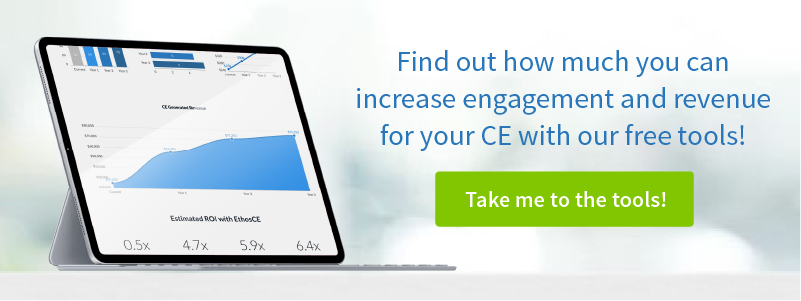We Built an LMS… So You Don’t Have To
At a recent conference we attended as a vendor, I was chatting with an education manager who was interested in the EthosCE learning management system. I gave her a demo and it seemed like a good fit. But then she dropped this bomb, “The product is great, but our IT department wants to build the LMS themselves.”
Ah, the age-old build vs. buy argument. Here’s my take (and, yes, of course it’s biased).
When we hear the build argument, the business case for building can often be boiled down to:
- Existing products don’t meet our need
- We can do it cheaper/faster/better ourselves
In this article, I am going to address those arguments and attempt to break them down.
“It Doesn’t Do What We Need it To Do”
 If your internal IT department says they can build it for less, make sure that they are giving you a fixed fee that takes into account all costs. Photo by JD Hancock
If your internal IT department says they can build it for less, make sure that they are giving you a fixed fee that takes into account all costs. Photo by JD HancockThere are hundreds of learning management systems on the market. Inside that group there are dozens of products in each vertical — healthcare, human resources, compliance, etc.
An adage in the LMS industry is that about 80 percent of the features of all those systems are the same. So, with hundreds of products on the market and multiple in each market vertical, are you sure none really meet your needs? If that’s the case I would suggest that 1) either the requirements include functionality outside of the scope of an LMS or 2) you have inflexible business requirements.
Inflexible Business Processes can Increase Costs
If you haven’t done it already, it’s an important exercise to identify the business requirements that are not met by off-the-shelf systems. Keep in mind that regulatory and compliance requirements are the same for everyone, so given that assumption, it’s likely that your internal business processes may be driving the gap.
Once the feature gap is identified, ask yourself, “are my requirements are fixed, or can they be modified to work with an off-the-shelf system?” If unique requirements are driving the decision to build versus buy, work to confirm that they are truly unique.
Many of the products on the market allow for configurable changes or customizations. With customization, the gap you identify may be filled by customizing the system to fit your needs. So you end up paying an extra fee for customization, but that fee will be smaller than the expense of building your own system from scratch.
Who Can Build it for Less?
If your internal IT department says they can build it for less, make sure that they are giving you an estimate that takes into account all costs. For example:
Labor Costs and Skills
Inquire about who is going to fill the following roles and tasks:
- Business analyst
- Running requirements meetings
- Documenting requirements
- Holding requirement review sessions with stakeholders
- Reviewing test castes and test plans
- Project manager
- Scheduling project resources and meetings
- Identifying and managing risks
- Running project meetings
- System architect
- Technical system design
- Technical leadership, mentoring
- Code reviews
- Product manager
- Specifying and prioritizing features
- Quality assurance manager
- Writing test cases
- Validating test results
- Quality assurance analysts
- Running tests cases
- Documenting test results
- Testing documentation
- Stress and load testing
- Exploratory testing
- Compliance manager
- Ensuring the team is following required compliance steps for software development. Consider HIPAA, PCI, etc.
- Deployment engineer
- Pushing code to production environments
- Automation
- Configuration
- Technical support manager
- Handling escalated technical issues
- Working with administrative users to provide assistance and help
- Technical writer
- Writing help documents for administrative and end users
That’s a lot of expertise. You might be able to skimp on a few of those skill sets, but each comes with an associated loss of quality.
Cost of Tools, Services and Hardware
All of those smart people need tools to do their jobs. Consider whether you have or would need to purchase tools such as:
- Requirements management database
- Test case management system
- Ticketing system for internal use
- Customer support system
- Software development libraries
- Deployment tools
- Test and staging servers
- Firewalls, production servers and bandwidth
- Backup services and data storage
- Compliance tools such as
- Central log management (SIEM)
- Antivirus systems
- Intrusion detection and file integrity systems (IDS, FIM)
- Compliance services such as
- Penetration and other scans
- Qualified external auditors
Human Resource Risk
If you don’t have a sizable software development group, you may be at risk when key people leave. This risk is exacerbated if you are using a proprietary system that other developers cannot easily step in and learn, or if your documentation is not robust and complete.
The cost of replacing and training a resource could add significant time and budget risk to your project, either in development or afterward in support.
Compliance Costs
If you’ve been reading this far along, you’ve noticed that we have included compliance resources. Some LMS environments may not have this need, but a common mistake is thinking that compliance doesn’t apply to your software. If you take payments, or operate in an environment where payments are accepted, store personally identifiable information or healthcare information, store financial records or are operating in an environment where such data is stored, you may be in scope for compliance.
Maintenance Cost of Reporting to External Bodies
Many of our customers report their learner records to external accreditation bodies. Those bodies can change their requirements at any time. For example, in healthcare, many of our customers report to the ACCME PARS system. That system has changed three times since its launch in 2011.
Commercial vendors will have to make these updates to stay in business. For example, monitoring and making such changes are included in our standard support package. If you build your own LMS you need to do do this yourself.
Speed to Deployment
It’s oft-quoted that most software development projects are delivered late. If you buy an existing system the software development is already complete, so timeline and budget risk will only apply to implementation and custom development.
Depending on your feature set, it might take months or years to develop a full-featured learning management system. Most off-the-shelf learning management systems can be deployed in days or weeks.
Quality
Would you rather be the first users of a new system or deploy a stable application that’s had dozens of bugs found, reported and fixed?
Feature Set Flexibility: What You Build Today Might Not be What you Need Tomorrow
Building a system that can do a few things is much simpler than building a flexible system hat can do many things. And hard-coding in business logic is much easier than making a configurable system. So when discussing the costs and timeline of building an LMS, consider whether your business requirements might change over time. For example:
- Payment types and methods
- Registration types and methods
- Course types (online, live, hybrid, etc)
- Course workflows
- Assessments and evaluations
- Credit types and eligibility scenarios
- Certificates
- External integrations
- Learning content objects
- Media support
You Get a Constant Stream of New Features
Good learning management systems are constantly improving and adding features. Those new features are usually included as part of your licence fee or contract.
Knowledge and Experience
All LMS vendors make mistakes and we’re no different. Between our management and staff we probably have over a hundred years of shared experience in building and implementing learning management systems. When you work with an external vendor, all that knowledge and experience is available to you: configurations, project management, implementations and support.
It would be hard to quantify the value of that experience, but consider the expense of potential mistakes such as difficult administrative user experience, data loss, security breaches, or learner dissatisfaction. Working with an experienced vendor will reduce the higher level of risk associated with being a first-timer at developing an LMS.
We’d be glad to talk over some of the details of building an LMS in detail and help you make the right decision. Contact us for more information.
 We're now part of the Cadmium product suite! Learn more
We're now part of the Cadmium product suite! Learn more 

